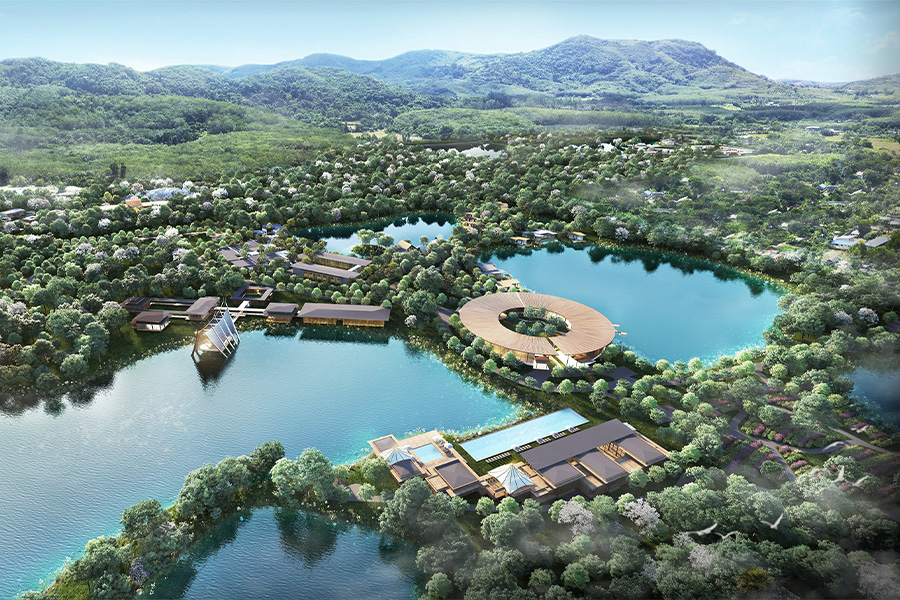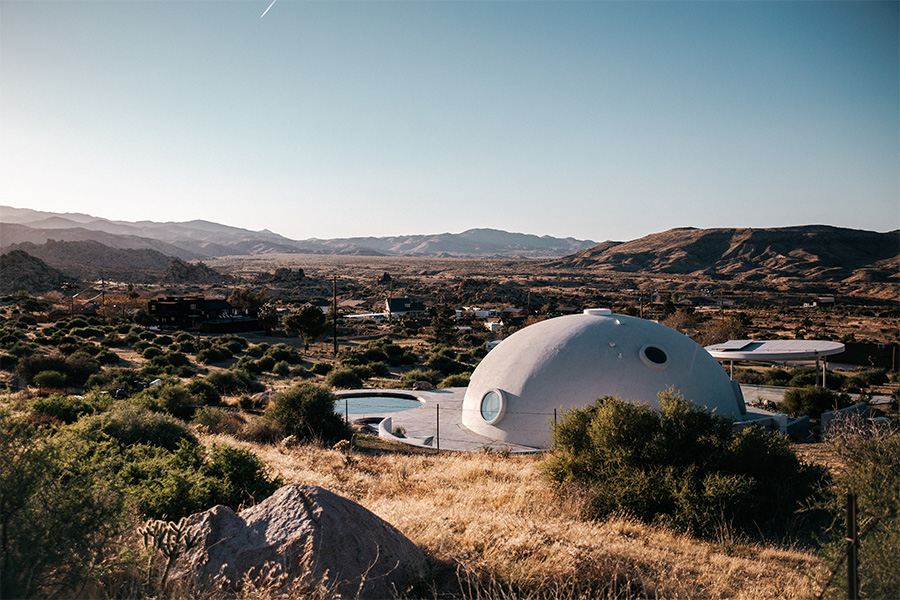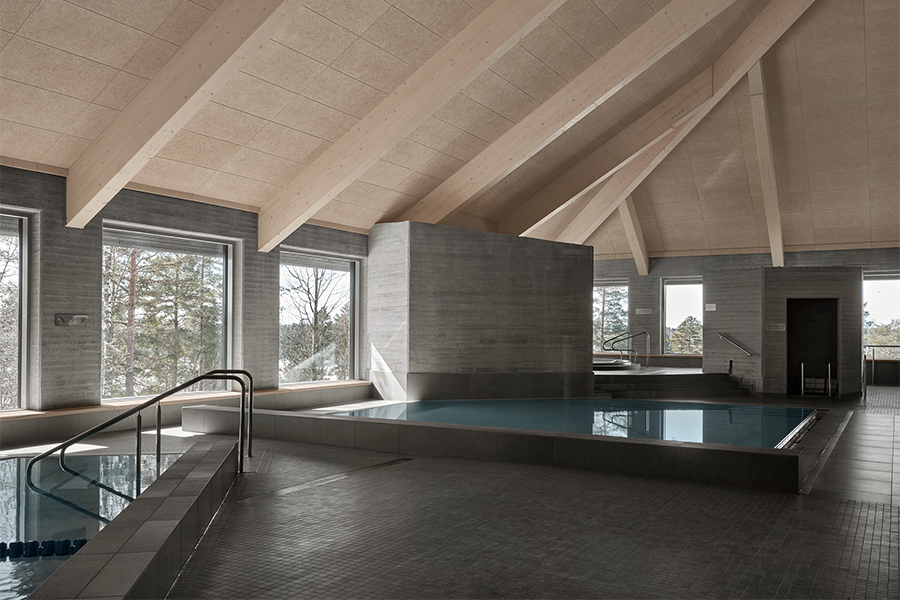A brighter, post-COVID-19 future is finally becoming a reality, but the way we once traveled belongs to the past. Between a pandemic and the much-needed confrontation of entrenched racism, the world has shifted, and so have the ways people want to navigate it.
In January 2021, Airbnb released a report indicating that instead of mass tourism, the priority is meeting up with loved ones in safe, familiar backdrops—a style of travel that has become more important to 41 percent of respondents. Affordability, locations accessible by car, and sustainability were also highly valued.
That growing interest in eco-friendly destinations mirrors the Ogilvy Wellness Gap Study unveiled in fall 2020 by the advertising, marketing, and public relations behemoth, which found that for 73 percent of respondents, wellness is an essential element of a brand’s strategy. Additionally, 62 percent of participants believed that a hotel should deliver such benefits to its guests.
Wellbeing, however, has a broad meaning. More than ever it is becoming synonymous with concepts like identity, cultural sensitivity, and inclusivity as much as nature, eco-tourism, and holistic traditions. These projects, spanning the hospitality, civic, and residential realms, embody thoughtful, impactful designs—ideas that will resonate with today’s purposeful, considerate consumers.
Holistic Wellbeing

A horseshoe-shaped bar wrapped in carved wood with a Black Forest marble countertop will greet residents at the AvroKO-designed community house at Tri Vananda
Designed to be both humble and peaceful, with a deep respect for the environment and sustainable building and design practices, forthcoming residential wellness community Tri Vananda is located across 237 forested acres in central Phuket, away from the beaches and city bustle. Complete with seven lakes and vegetated sand dunes, the resort “is seen as an ethereal realm,” says Carl Almeida, project and design director at Bangkok-based P49 Deesign, which led the interior design on the residential villas and wellness resort. “[It’s] a safe haven where one can revitalize their health and wellbeing, both physically and mentally.”
The property centers around pillars of mindfulness, biophilia, integrative medicine and nutrition, and multigenerational living. With architecture executed by Habita Architects and Arsomsilp Community and Environmental Architect, the villas are reminiscent of tropical vacation homes with natural and engineered woods, rattan, and woven leather sofas. Tri Vananda wellness initiatives prioritize sleep, so the villas also feature a proprietary circadian lighting system, wifi blockers, aromatherapy, and responsive air purification systems.
A focal point of the resort is the AvroKO-designed community house. Comprising a bar and lounge, multipurpose space, gym, and adults-free Tweenie Club, the space encourages a healthy lifestyle via community engagement.
“This project will show you do not need to be at the beach in Phuket to have an exceptional way of life,” Almeida says. “A retreat back to a forested nature can enhance our overall wellbeing significantly, and this vision can promote a more sensible approach to development. Sustainability and wellbeing do not detract from the design—they enhance [it].”
Inclusive Hospitality
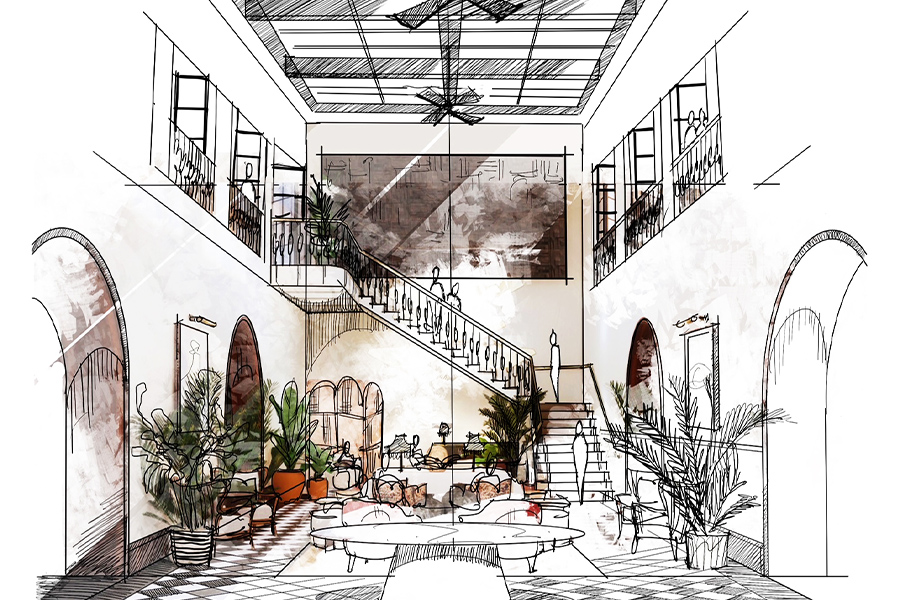
A sketch of Homage Hospitality’s Hotel Gordon, which will cater to the community in Albany, Georgia when it opens in 2022
During the pandemic, Damon Lawrence, founder and CEO of Homage Hospitality, drove across the country from his home in Oakland, California to Albany, Georgia. It was the first time he had seen cotton growing, yet the landscape felt familiar. “I started to think about the history there. So much of it was spurred by tragedy and pain, but I was rolling over those hills to see a hotel project that I’m working on, and to a certain extent that represents how far we’ve come and how far we still have to go,” he says.
Lawrence, who graduated from Howard University, founded Homage in 2016 to illuminate Black narratives in an industry where they are markedly absent, despite the fact that Black travelers spend approximately $60 billion annually. Through his forthcoming collection of Black-owned and Black-managed hotels, he is keen to amplify the histories of their locations.
Albany, found on the Flint River in southwest Georgia, was an epicenter of the civil rights movement. In 1961, the desegregation and voters’ rights coalition known as the Albany Movement unfolded here, while the roving quartet, the Freedom Singers, was founded the following year at what was then called Albany State College—now Albany State University, one of the largest HBCUs in the country.
Set in a former hotel dating from the early 1900s that morphed into the city’s water, gas, and electric company building, the Hotel Gordon will open in 2022. In the meantime, Lawrence and design collaborator Nina Grondin, partner and cofounder at Chicago and Merida, Mexico-based Curioso, are actively listening to residents and historians to develop a hotel that caters to the needs of the community. “It’s important to tell the real story of a place and to share the roots of Black culture and how that affects who we are as Americans today,” she says.
Downtown teems with vacant storefronts, and Lawrence and Grondin see the hotel bringing a jolt of vibrancy—a catalyst for Albany’s redevelopment—leading them to ask, “How can we make a hotel where everyone is included?” says Lawrence. “How can we create a space that everyone is proud to have in their city?”
Remote Retreats
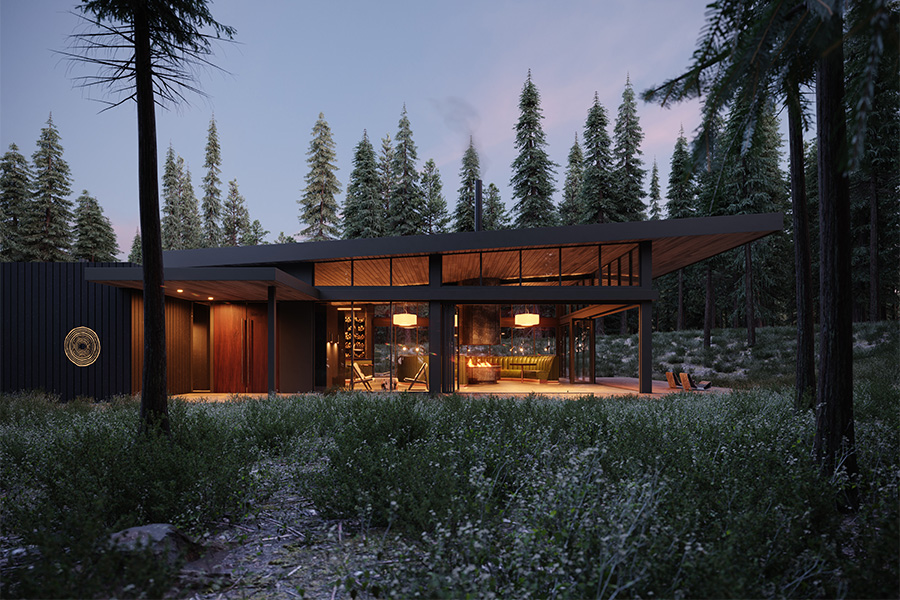
Shown in a rendering, the Mutuus Studio-designed Social Haus at Green O in Montana will immerse guests in nature via floor-to-ceiling windows
The now-ubiquitous term “glamping” was first coined by the Resort at Paws Up in Greenough, Montana, which opened in 2005 with three tents. Ever since, the 37,000-acre working cattle and bison ranch has attracted guests with its mix of adventure, design, and cuisine. Now, owner Laurence Lipson is gearing up to introduce adults-only sister concept Green O, offering year-round ultra-luxe glamping “deep in the timberland of the most southern edge of the Paws Up Ranch,” he explains.
With a capacity for 24 guests who sleep in one of 12 “hauses” outfitted with “floor-to-ceiling glass that greets the wilderness, the Green O is one of the most intimate and private resorts in America,” says Lipson.
By contrast, the earth-toned Social Haus restaurant, bar, and lounge—designed by Seattle’s Mutuus Studio is where guests gather amid a patinated copper fireplace, charred wood cladding, and glazed raku-fired tiles. In the center, a curved banquette in dark green leather recalls the “Green O story and the legacy of the former rancher on the property who would spray a green ‘O’ on the sheep to help keep track of them,” says Mutuus partner Kristen Becker.
Eco-Immersion

The eco-resort Habitas Bacalar will comprise 35 palapas with lagoon-facing views when it opens on Mexico’s Laguna Bacalar this summer
Many travelers today are looking for a transformative experience, and perhaps no company has honed in on this market more than Habitas. Dubbed a “global home for a global community of likeminded people seeking connection, inspiration, and a better future together,” the mission of the experience-led hospitality group is about escape, restoration, and reflection. Joining Habitas’ growing portfolio, which counts destinations in Namibia and Tulum, will be Habitas Bacalar, set in the mango and coconut forests of Mexico’s Yucatan peninsula and slated to open this summer.
Upon arrival, guests will glimpse the site’s lagoon, with its striking blue hues and ancient reef-like formations. They will then be ushered off to one of the 35 A-frame palapa structures with open decks oriented toward the crystalline waters. Every detail, in fact, “is designed to integrate with nature,” says Habitas cofounder and CEO Oliver Ripley, “from the organic and local materials we use to how we preserve plant life and trees to how we build.”
Specific attention was given to the local Mayan culture, immersing guests in the land and its traditions via Habitas’ wellness programs and F&B concepts. “We also worked with local communities, farms, and therapists to create a holistic approach for our guests,” says Ripley, whether that’s paddleboard yoga or sunrise mediations. Indeed, “wellness is woven into the fabric of everything we do,” he adds, noting that guests are equipped with tools to continue their journeys long after they return home.
Sustainability is also top of mind, with a focus on preserving the lagoon because of its stromatolites (the sedimentary formations contain micro-organisms dating back to the origins of the planet that are only found in a handful of places), which are crucial to the lagoon’s ecosystem. “Our home is designed to leave minimal impact on the surroundings,” explains Ripley, adding that everything Habitas buys and sources will support the local community and aim to create micro-economies in the area. “This is integral to our ethos—helping local farmers and artisans and training and teaching the local workforce.”
Local Influence
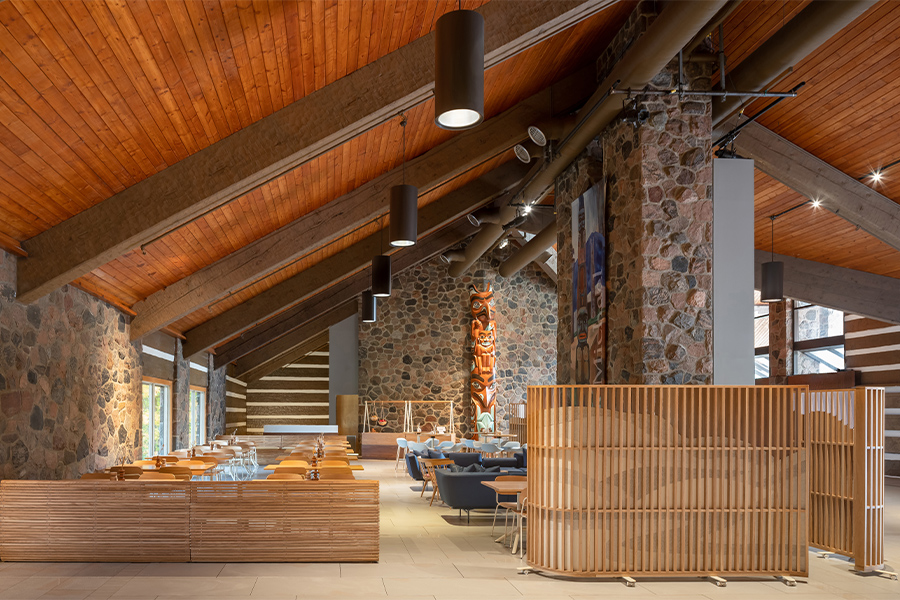
Local wood clads the McMichael Café in Ontario, a project conceived by Denizens of Design to reflect the work of the Group of Seven artists
Dyonne Fashina’s great-grandfather studied painting under A.J. Casson, one of the Canadian landscape artists comprising the 20th-century Group of Seven, so the principal at Denizens of Design had a personal connection to the McMichael Canadian Art Collection in Kleinburg, Ontario, which is home to the series of wilderness paintings by the group.
In collaboration with the gallery’s hospitality partner the Food Dudes, the Toronto firm reimagined the McMichael Café, a welcoming space in the entrance hall that transforms from lunchtime dining to evening and weekend events. “The goal was to create a space reflective of the gallery’s identity, the building’s architecture, the work found inside, and the ideals of the original founders, Signe and Robert McMichael. It’s their story I wanted to tell,” Fashina explains.
To capture this heritage and remain mindful of the indigenous land the building sits on, Fashina and her team turned to local wood, including a tree that was felled just outside the grounds. “We wanted to avoid a mass-produced, Eurocentric aesthetic, which would conflict with the identity of the gallery,” says Fashina.
Bringing together multiple Canadian makers was key to the vision. Textile artist Diana Watters’ felt details adorn the slatted divider screens, for example, while the host stand is crafted from walnut by woodworker Heidi Earnshaw, “to create a collection of objects that are independently beautiful but collectively meaningful,” says Fashina.
Cultural Sensitivity
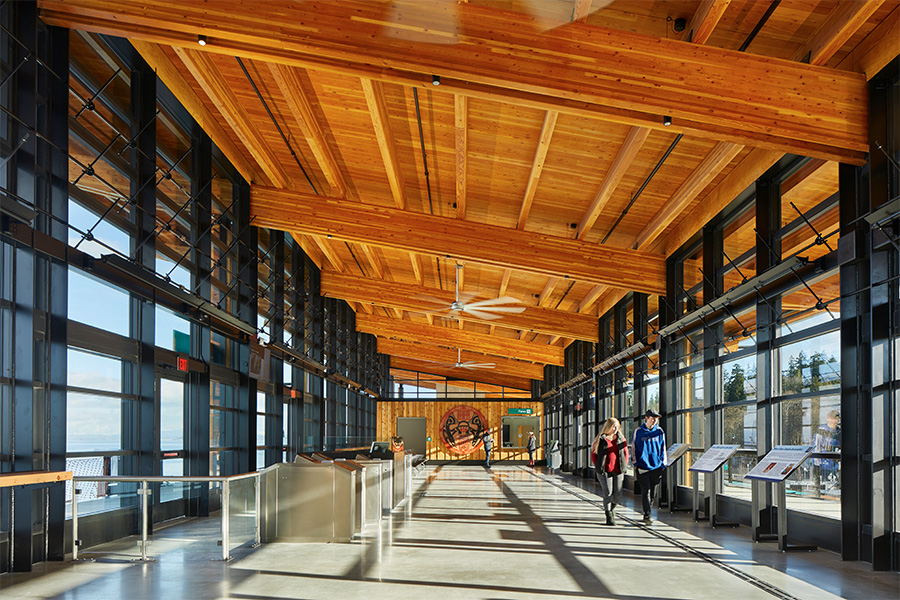
LMN Architects worked closely with the Coast Salish tribes when developing the Mukilteo Mulitmodal Ferry Terminal near Seattle, which derives its look from historical longhouses
In a design brief outlined by the State of Washington, one of the directives for the new bi-level Mukilteo Multimodal Ferry Terminal and toll plaza, which links the communities of Mukilteo and Clinton, was to pull inspiration from the indigenous buildings of the local Coast Salish Tribes. That would be the longhouse, “a simple log-framed structure with planks on the walls and a shed roof,” says Howard Fitzpatrick, principal at Seattle-based LMN Architects, which partnered with KPFF Consulting Engineers on the design. But “a building resembling the traditional longhouse in its construction would be little more than an imitation, a theme-park building. We wanted to acknowledge the vibrancy of the Tribal culture, its persistence over time, and its forward-looking orientation.”
Visits with the Tribes, where insights were gleaned from senior leadership, informed the respectful revamp of a location that had previously been used to store jet fuel. To connect the project to the history of the sacred site, wood carvings and glass art by Joe Gobin and James Madison of the Tulalip Tribe and metalwork by Kate Ahvakana of the Suquamish Tribe are featured, as well as a plaque commemorating where the Treaty of Point Elliott was signed in 1855, guaranteeing perpetual hunting and fishing rights to the Tribes.
That devotion to the past is balanced with a vision for sustainability, integrating the likes of solar panels and natural ventilation. Western Red Cedar and Douglas Fir, woods traditionally embraced in longhouse construction, complement polished concrete floors, glass walls, and self-oxidizing steel panels, which recall the rusted fuel tanks of the ferry’s former life. “The idea of ‘living light on the Earth’ became a guiding principle,” he says. “We used the materials in a straightforward and frank way.”
This article originally appeared in HD’s April 2021 issue.
More from HD:
Six Senses Partners with U.S. Coalition on Sustainability
3 Bold Projects Push the Boundaries of Sustainability
Casa na Terra Seamlessly Coexists With Its Surroundings

